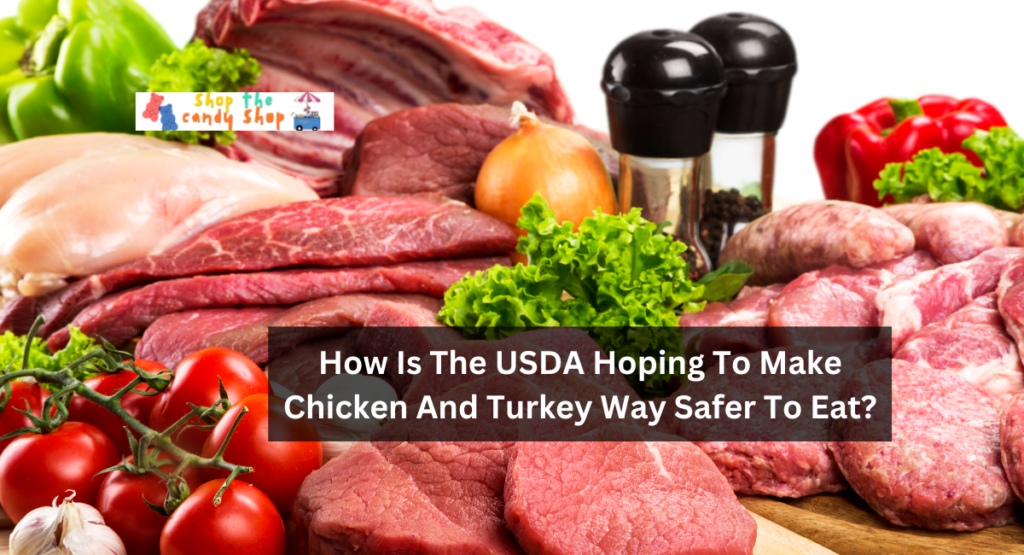Chicken and turkey are commonly eaten in American homes, providing a healthy source of protein. But worries about getting sick from food, especially from bacteria like Salmonella and Campylobacter, have made it increasingly necessary to ensure that chicken is safe to eat.
The USDA has worked to make chicken and turkey safer, introducing new rules to lower the chances of contamination. This article examines how the USDA is trying to make chicken and turkey safer and what this means for people who eat these meats.
USDA Takes Strong Stance Against Salmonella In Poultry
New Proposal For Safer Poultry
The U.S. Department of Agriculture (USDA) and its Food Safety and Inspection Service (FSIS) are working harder to prevent Salmonella from entering chicken and turkey products.
On July 29, the FSIS announced a new plan to make chicken safer by fixing contamination problems.
What Does The New Rule Propose?
The new rule suggests tougher rules for chicken farmers. The regulations will be more strict. The changes will impact poultry producers. It would:
- Stop selling chicken and turkey that have a lot of Salmonella in them.
- Safety procedures at poultry plants need to be updated. The plants should have better methods to prevent contamination. This includes:
- Implementing a microbial monitoring program.
- Sampling poultry at different stages, including after rehang and post-chill, to ensure safety.
Ongoing Efforts To Combat Salmonella
This new proposal is part of a larger, ongoing effort to reduce Salmonella cases:
Previous Changes
In 2022, the USDA suggested making Salmonella a harmful substance in breaded and stuffed raw chicken products. This was done to lower the number of illnesses caused by Salmonella, leading to millions spent on healthcare and more than 400 deaths yearly.
Expected Benefits
The FSIS estimates that the new rule could provide significant benefits:
Predicted Savings: It might save society around $20.5 million every year. This includes stopping sickness, which could save up to $12.9 million each year.
Effect On Industry: The rule could also help the poultry industry avoid expensive product recalls.
New Initiatives And Future Plans
The USDA is looking for new ways to make poultry safer to eat. They have started new projects to ensure people don’t get sick from eating poultry.
1. Pilot Programs For Innovative Technologies
The USDA is trying out new technologies in chicken processing plants. These technologies can find bacteria faster and more accurately and help prevent contamination during processing.
The USDA wants to try these technologies in actual settings to find the best tools for making poultry safer. Then, it will make these tools easier for producers to access.
2. Updated Regulatory Framework
The USDA is working to make poultry production safer by updating its regulations. This ongoing effort is aimed at improving food safety. This involves updating current rules based on new science and suitable methods. It’s important to stay current with research.
Strengthening regulations will help keep consumers safe from food poisoning and help the poultry industry maintain high safety levels.
3. Collaborative Efforts With Industry And Academia
The USDA knows that making poultry safer requires working with industry, researchers, and government agencies. Collaboration is key to improving safety. The agency partners collaborate with poultry producers to create and follow best practices, which help lower the risk of contamination.
The USDA works with schools to study food safety and create better ways to control pathogens in poultry. They research this topic and develop new methods.
What This Means For Consumers?
The USDA is making chicken and turkey safer for people to eat. They are making rules stricter, updating how they check the meat, and encouraging good practices before it gets to you. This helps lower the chance of you getting sick from the food. It’s still essential for you to be careful and cook the meat properly at home.
Tips For Safe Poultry Preparation
Cook Thoroughly: Always cook chicken and turkey until they reach 165°F (74°C) inside to kill harmful germs.
Prevent Mixing Germs: To prevent Cross-Contamination, Use different cutting boards and utensils for raw chicken and other foods. Wash your hands, surfaces, and utensils well after touching raw chicken.
Store Properly: Please ensure that the chicken is stored properly by placing it in refrigerator at a temperature of 40°F or lower. It is recommended to use the chicken within a few days or freeze it for future use.
By doing these easy things, people can feel more sure about eating chicken and turkey because the USDA makes them safer.
The USDA is working hard to make chicken and turkey safer to eat. They are conducting more tests, updating inspections, and examining the whole process from the farm to your plate, helping to lower the chance of getting sick from food. As these efforts progress, customers can expect safer chicken products and help with food safety by correctly handling and cooking the food at home.
Thank you for reading the article. Hope you like it…..


